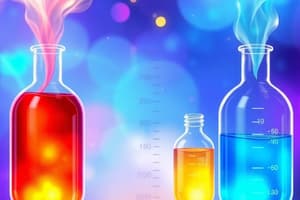Podcast
Questions and Answers
Explain how the Brønsted-Lowry theory broadens the definition of acids and bases compared to the Arrhenius theory. Provide an example of a substance that is a base according to Brønsted-Lowry but not Arrhenius.
Explain how the Brønsted-Lowry theory broadens the definition of acids and bases compared to the Arrhenius theory. Provide an example of a substance that is a base according to Brønsted-Lowry but not Arrhenius.
Brønsted-Lowry defines acids as proton donors and bases as proton acceptors, while Arrhenius defines acids as producing $H^+$ in water and bases as producing $OH^-$ in water. Ammonia ($NH_3$) is a base according to Brønsted-Lowry because it accepts protons, but it doesn't produce $OH^-$ ions in water, so it is not a base according to Arrhenius.
A solution has a pH of 3.0. If you dilute this solution by a factor of 100, what will be the approximate new pH, assuming ideal behavior?
A solution has a pH of 3.0. If you dilute this solution by a factor of 100, what will be the approximate new pH, assuming ideal behavior?
The new pH will be approximately 5.0. Diluting an acidic solution decreases the concentration of $H^+$ ions. Each 10-fold dilution increases the pH by one unit.
Describe the chemical process of neutralization. What products are typically formed during this reaction, and how does it relate to changes in pH?
Describe the chemical process of neutralization. What products are typically formed during this reaction, and how does it relate to changes in pH?
Neutralization is the reaction between an acid and a base, producing a salt and water. This process moves the pH of the solution towards neutral (pH 7) by reducing the concentration of excess $H^+$ or $OH^-$ ions.
How do strong acids and weak acids differ in terms of their dissociation in water, and what impact does this have on the concentration of hydrogen ions ($H^+$) in their solutions?
How do strong acids and weak acids differ in terms of their dissociation in water, and what impact does this have on the concentration of hydrogen ions ($H^+$) in their solutions?
Discuss the composition and mechanism of a buffer solution. How does it resist changes in pH when small amounts of acid or base are added?
Discuss the composition and mechanism of a buffer solution. How does it resist changes in pH when small amounts of acid or base are added?
Explain how the reaction between a strong acid and a strong base leads to the formation of a neutral salt. Provide an example with chemical formulas.
Explain how the reaction between a strong acid and a strong base leads to the formation of a neutral salt. Provide an example with chemical formulas.
Describe two major environmental impacts of acid rain. How do these impacts affect ecosystems and man-made structures?
Describe two major environmental impacts of acid rain. How do these impacts affect ecosystems and man-made structures?
Explain the role of sulfur dioxide ($SO_2$) and nitrogen oxides ($NO_x$) in the formation of acid rain. What are the primary sources of these pollutants?
Explain the role of sulfur dioxide ($SO_2$) and nitrogen oxides ($NO_x$) in the formation of acid rain. What are the primary sources of these pollutants?
How can you experimentally determine if a salt formed from a neutralization reaction will produce an acidic, basic, or neutral solution when dissolved in water?
How can you experimentally determine if a salt formed from a neutralization reaction will produce an acidic, basic, or neutral solution when dissolved in water?
If a scientist adds a strong acid to a buffer solution, what chemical reaction occurs to minimize the change in pH? Use the example of an acetic acid/acetate buffer to illustrate.
If a scientist adds a strong acid to a buffer solution, what chemical reaction occurs to minimize the change in pH? Use the example of an acetic acid/acetate buffer to illustrate.
Flashcards
Acids
Acids
Substances that donate protons (H+) or accept electrons.
Bases
Bases
Substances that accept protons (H+) or donate electrons.
pH Scale
pH Scale
A measure of acidity or basicity, ranging from 0 to 14.
Neutralization
Neutralization
Signup and view all the flashcards
Salts
Salts
Signup and view all the flashcards
Arrhenius Theory
Arrhenius Theory
Signup and view all the flashcards
Bronsted-Lowry Theory
Bronsted-Lowry Theory
Signup and view all the flashcards
Lewis Theory
Lewis Theory
Signup and view all the flashcards
Acid Rain
Acid Rain
Signup and view all the flashcards
Buffers
Buffers
Signup and view all the flashcards
Study Notes
- Acids, bases, and salts are fundamental chemical compounds with distinct properties and roles in various chemical reactions
Acids
- Acids donate protons (H+) or accept electrons
- Acids taste sour
- Acids turn blue litmus paper red
- Acids have a pH less than 7
- Acids react with certain metals to produce hydrogen gas
- Acids neutralize bases
- Strong acids completely dissociate into ions in water
- Examples of strong acids include hydrochloric acid (HCl), sulfuric acid (H2SO4), and nitric acid (HNO3)
- Weak acids only partially dissociate into ions in water
- Examples of weak acids include acetic acid (CH3COOH) and carbonic acid (H2CO3)
- Acids are used in industrial processes like the production of fertilizers, plastics, and synthetic fibers
- Acids catalyze chemical reactions
- Concentrated acids can be corrosive and cause burns
Bases
- Bases accept protons (H+) or donate electrons
- Bases taste bitter
- Bases feel slippery to the touch
- Bases turn red litmus paper blue
- Bases have a pH greater than 7
- Bases neutralize acids
- Strong bases completely dissociate into ions in water
- Examples of strong bases include sodium hydroxide (NaOH) and potassium hydroxide (KOH)
- Weak bases only partially dissociate into ions in water
- Examples of weak bases include ammonia (NH3) and pyridine (C5H5N)
- Bases are used in industrial processes, including the production of soaps, detergents, and paper
- Bases are also used as cleaning agents and in antacids
- Concentrated bases can be corrosive and cause burns
pH Scale
- The pH scale measures the acidity or basicity of a solution
- The scale ranges from 0 to 14
- A pH of 7 is neutral
- A pH less than 7 is acidic
- A pH greater than 7 is basic (or alkaline)
- pH is defined as the negative logarithm of the hydrogen ion concentration ([H+])
- pH = -log[H+]
- pH can be measured using pH meters or indicators
- pH indicators are substances that change color depending on the pH of the solution
Neutralization
- Neutralization is the reaction between an acid and a base
- An acid and a base react to form a salt and water
- The general equation for neutralization is: Acid + Base → Salt + Water
- For example: HCl (acid) + NaOH (base) → NaCl (salt) + H2O (water)
- Neutralization reactions are exothermic, meaning they release heat
Salts
- Salts are ionic compounds formed from the reaction between an acid and a base
- Salts are composed of positively charged ions (cations) and negatively charged ions (anions)
- Salts are typically crystalline solids at room temperature
- Salts are generally soluble in water
- Examples of salts include sodium chloride (NaCl), potassium nitrate (KNO3), and calcium carbonate (CaCO3)
- Salts are used in various applications, such as food preservation, fertilizers, and the production of chemicals
- Salts can be acidic, basic, or neutral, depending on the strengths of the acid and base that formed them
- Acidic salts are formed from the reaction of a strong acid and a weak base
- Basic salts are formed from the reaction of a weak acid and a strong base
- Neutral salts are formed from the reaction of a strong acid and a strong base
Acid-Base Theories
- Arrhenius Theory: Acids produce H+ ions in water, and bases produce OH- ions in water
- Bronsted-Lowry Theory: Acids are proton (H+) donors, and bases are proton acceptors
- Lewis Theory: Acids are electron pair acceptors, and bases are electron pair donors
Acid Rain
- Acid rain is precipitation that is unusually acidic, with elevated levels of hydrogen ions (low pH)
- Acid rain is caused by emissions of sulfur dioxide (SO2) and nitrogen oxides (NOx), which react with water molecules in the atmosphere to produce acids
- Major sources of SO2 and NOx are the burning of fossil fuels (coal, oil, and natural gas) and industrial processes
- Acid rain has harmful effects on ecosystems, including damage to forests, acidification of lakes and streams, and harm to aquatic life
- Acid rain can also damage buildings, monuments, and other structures made of stone or metal
Buffers
- Buffers resist changes in pH when small amounts of acid or base are added
- Buffers typically consist of a weak acid and its conjugate base, or a weak base and its conjugate acid
- Buffers work by neutralizing added acid or base, preventing large changes in pH
- Examples of buffer systems include acetic acid/acetate and ammonia/ammonium
- Buffers are important in biological systems to maintain a stable pH, which is essential for enzyme activity and other biochemical processes
Studying That Suits You
Use AI to generate personalized quizzes and flashcards to suit your learning preferences.




